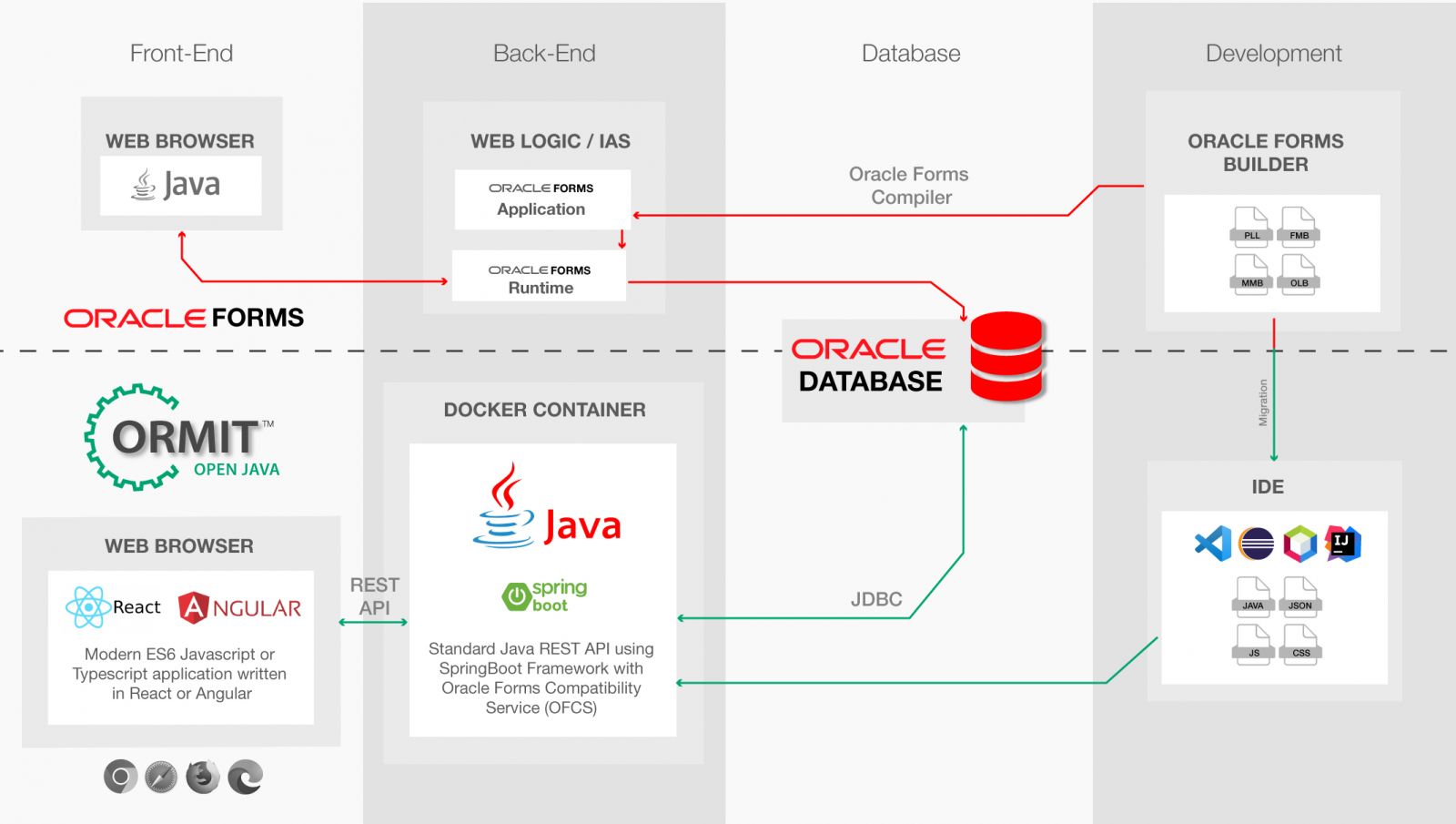Understanding ORMIT™-OpenJava’s Oracle Forms compatibility service
Understanding ORMIT™-OpenJava’s Oracle Forms compatibility service
The Oracle Forms compatibility service (OFCS) is a critical component in the ORMIT™-OpenJava architecture, designed to ensure compatibility with Oracle Forms features while embracing modern web standards. Its inclusion is intentional and allows for seamless handling of legacy Forms logic, centralized validation, and optimized code management.
Titleimage
Posted by RENAPS Team on 2025:03:07 15:54:59
Understanding ORMIT™-OpenJava’s Oracle Forms compatibility service
Overview
The Oracle Forms compatibility service (OFCS) is a critical component in the ORMIT™-OpenJava architecture, designed by RENAPS to ensure compatibility with Oracle Forms features while embracing modern web standards. Its inclusion is intentional and allows for seamless handling of legacy Forms logic, centralized validation, and optimized code management.
Key Roles of the Oracle Forms compatibility service (OFCS)
1. Maintaining Oracle Forms Compatibility
OFCS ensures that the migrated application retains full compatibility with key Oracle Forms features, including:
- Items and fields rendering
- Built-in functions
- Triggers
- All access permissions originally embedded in Oracle Forms
This ensures that even after migrating to a modern web platform, the user experience and business logic remain consistent with the original Oracle Forms behavior.
2. Symmetrical Data Validation
OFCS acts as the unified business logic layer, ensuring that all data validation rules are applied identically in both the frontend and backend. This prevents duplication of validation logic and ensures consistent enforcement of business rules across all layers.
3. Single Source of Business Logic
With the OFCS acting as a central processing point, business logic is written once and reused across both:
- The frontend (for client-side validation and behavior)
- The backend (for transactional processing and database interaction)
This drastically reduces development overhead, eliminates inconsistencies, and aligns with modern software engineering principles.
Summary Table: Technological Components of ORMIT™-OpenJava
| Architecture Component | Description |
|---|---|
| Backend - Java Spring Boot (REST API) |
The backend serves as the core of the application, responsible for handling data persistence, authentication, authorization, and API exposure. Exposes REST APIs, handles transactions, manages persistence via JDBC Connection (such as HikariCP). Our Backend can interact (when/if needed) with the symmetrical data validation (OFCS). |
| Frontend – React or Angular (UI Layer) |
The frontend provides an intuitive and dynamic user interface for interacting with the application. Modern user interface, handles presentation and user interactions. Front End validation benefits from the OFCS symmetrical data validation as well. |

Example
What Happens When You Click “Save”: A Behind-the-Scenes Look at ORMIT™-OpenJava + OFCS
When migrating from Oracle Forms to a modern Java-based architecture using ORMIT™-OpenJava, we ensure that your business logic, validations, and user experience are preserved — but now powered by clean APIs and a maintainable frontend.
Here’s what happens under the hood when a user clicks the “Save” button (equivalent to Oracle Forms' "when-button-pressed"):
1. User Clicks “Save” on the Frontend
Just like in Oracle Forms, this action mimics a WHEN-BUTTON-PRESSED trigger. The frontend captures this event and prepares to process the form data.
2. Frontend Validation
Before calling the backend, the frontend performs basic validation such as:
- Are all required fields filled?
- Are numbers and dates correctly formatted?
This improves user experience by catching simple errors early — before calling the server.
3. REST API Call to Backend Endpoint using POST method
Once validation passes, the frontend sends the form data to the backend using a POST request to API Endpoint. This is the modern equivalent of committing the form in Oracle Forms.
4. Backend Calls OFCS for Business Logic Validation
On the backend, the request goes through the OFCS, which plays a key role in replicating the behavior of Oracle Forms triggers and logic.
OFCS validations examples:
- Validating data types and field lengths
- Checking mandatory fields
- Running complex business rules from the original Forms logic
- Enforcing data integrity and consistency
Any failure here is returned as a structured error — just like a FORM_TRIGGER_FAILURE in the legacy Forms environment.
5. Database Insertion (Only if Validation Succeeds)
If OFCS confirms the data is valid:
- The backend inserts the new record into the database
- A 200 OK response is sent back to the frontend
If validation fails, an error response is returned, and the frontend displays user-friendly validation messages to correct the input.
Key Benefits for Customers
- Faster UI and instant user feedback (even more apparent on weak or unstable internet connection such as a mobile devide)
- Prevents duplication of validation and business rules between frontend and backend.
- Reduces server load by eliminating unneeded server calls
- Reduces REST API errors occurences by catching errors before they are submitted to the back-end
- Preserves Oracle Forms business logic and access control without rewriting everything from scratch.
- Modern, decoupled architecture enabling better scalability and maintainability.
- Streamlined development process with a single source of truth for business logic while ensuring to maintain all past investments in Oracle Forms business logic intact.
Final Note
This unique approach ensures that ORMIT™-OpenJava delivers not just a technical migration, but a future-proof, cloud-ready architecture that retains the value of your existing Oracle Forms investment while embracing the flexibility and scalability of modern web technologies.
Posted by RENAPS Team on 2025:03:07 15:54:59